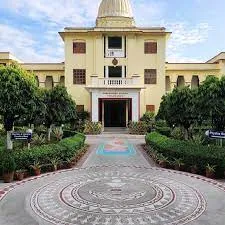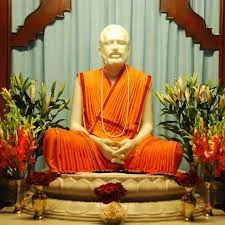The Ramakrishna Mission was instituted to stand as a bridge for the Hindu religious traditions. Ramakrishna Mission (RKM), one of India’s most respected philanthropic organizations, has been functioning since 1897. Swami Vivekananda, a famous Indian spiritual leader who influenced the Western world in the 19th century, established RKM in the name of Sri Ramakrishna Paramahamsa Deva, his spiritual teacher (“guru”) who is regarded by millions of people as the Prophet of the Modern Age.
RKM is a Hindu religious, spiritual and philanthropic organisation headquartered in Belur Math, West Bengal.
The Mission was envisioned to exemplify Swamiji’s plan of action through the practice and propagation of the Universal Religion of Vedanta. The main thrust is to take care of the poor, the illiterate, the ignorant, and the afflicted.
The Mission acquired legal status when it was registered in 1909 under Act XXI of 1860. Its management is vested in a Governing Body. Though the Mission with its branches is a distinct legal entity, it is closely related to Math.
He realized that Indian society had three vital problems.
- The masses (i.e. the lower castes) and women (of all castes) had been grossly neglected and tortured. This was the first weakness.
- Secondly, people of all castes, religions and races in India had completely lost all enthusiasm for life. They lacked the joie de vivre that is natural in living human beings.
- India was a unique nation in the sense that religion was its life-breath.
The motto of the Ramakrishna Mission is Atmano Mokshartham Jagaddhitaya Cha. It means “for one's own liberation and for the welfare of the world”. The best quote of Sri Ramakrishna : "Knowledge leads to unity, but Ignorance to diversity." "Lovers of God do not belong to any caste." "Never get into your head that your faith alone is true and every other is false. Know for certain that God without form is real and that God with form is also real.
The Ramakrishna Mission is to change the way an institution of Vedanta should henceforth look upon humans. It promotes mainly the following goals:
- Cultivating purity, unselfishness, discipline and learning, to effectively influence and lead the society toward universal Vedantic enlightenment.
- Creating new communities and institutions that would serve the cause of the Hindu Dharma.
- Encouraging such social practices and individual habits which would enhance the physical strength and vitality of the Hindu race.
- Experimenting with new enterprises based on science and technology, which could raise the standards of human life.
- Rendering equal rights and privileges to all in receiving the sacraments (saṁskāras), studying the scriptures and observing the religious rites.
- Realising its long-term goals through continuity of policy and successive generations of followers.
Swami Vivekananda established the Ramakrishna Math and Ramakrishna Mission, two organizations, headquartered at Belur Math in Howrah. The question comes why two organisations and what its objective?
The Math would cater to the spiritual education of the masses, while the Mission would cater to the rest of the activities that Indian society needed to molt itself out of its slough. Only monks would be members of the Math, while monks and married people could both be members of the Mission.
In due course, these two organizations were registered with appropriate authorities as legal entities. These two organizations represented two limbs, as it were, of the Indian Renaissance movement that Swamiji initiated. While the Math kept a firm grip over the timeless and essential traditions of India’s spiritual culture, the Mission attended to the problems of humanity and served the needy and hapless as part of the spiritual discipline of the members.
Swamiji wanted to instill the idea of self-help in his fellow countrymen. There was all round deterioration in the standard of living, which had to be immediately addressed. Whether it was activities aimed at educating & upskilling ourselves, or activities aimed at famine, disaster or epidemic relief, we had to learn how to do it ourselves, instead of looking up to our ‘leaders’ for help. In an unprecedented burst of activity, work started on all fronts.
What is important for us to note is the new ritual he initiated through the Ramakrishna Mission. He said, “The only God to worship is the human soul in the human body.
Of course, all animals are temples too, but man is the highest, the Taj Mahal of temples. If I cannot worship in that, no other temple will be of any advantage.
The moment I have realized God sitting in the temple of every human body, the moment I stand in reverence before every human being and see God in him — that moment I am free from bondage, everything that binds vanishes, and I am free. This is the most practical of all worship. It has nothing to do with theorizing and speculation."
We can gauge the power unleashed by this Prophet of New India by looking at the activities of the Ramakrishna Mission in the 100 years since his passing away. Today we have :
- 1417 educational institutions imparting academic and livelihood skills to over 3.28 lakhs boys and girls annually.
- over 1168 dispensaries, mobile medical units and hospitals rendering vital medical aid to over 81 lakhs beneficiaries annually.
- Around Rs. 14 crores was spent on different kinds of Relief & Welfare activities in which over 41 lakhs beneficiaries received assistance.
- Around 26,000 boys & girls received skill development training in over 700 skill development centers.
- Apart from the educational and healthcare activities in the rural tribal areas, the Mission spent over Rs. 41 crores on purely rural & tribal development activities.
In October 2010, as a part of the four-year-long 150th birth anniversary celebration of Swami Vivekananda, RKM undertook a pan-India project named the “Gadadhar Abhyudaya Prakalpa” (GAP) -- A Humanitarian Initiative of Ramakrishna Mission for Underprivileged Children.
It was one of the main outcomes that Swamiji had in mind when he started the Ramakrishna Mission.
The Ramakrishna Mission started in 1899 incorporating the true democratic principles of ‘Self-help’, and ‘Self-governance’. However, there is one vital ingredient in the workers associated with the Ramakrishna Mission which makes them stick to the founding principles in letter and in spirit, which is the attitude of ‘Service to man is service to God’.
Swamiji repeatedly pointed out that ‘Renunciation & Service are the twin ideals for India’. Perceptibly, Ramakrishna Mission is playing a pivotal role in the development of the Nation. It is out of place to mention for development on such a massive scale, governmental machinery is indispensable.
No doubt Ramakrishna Mission stands as a beacon of light showing the way. The attitude of the people involved in the evelopmental activity is what finally decides the fruitfulness of the activity.
As of 7 March 2022, the Ramakrishna Mission and Ramakrishna Math have 265 centres all over the world: 198 in India, 26 in Bangladesh, 14 in the United States, 2 each in Brazil, Canada, Russia, South Africa and one each in Argentina, Australia, Fiji, France, Germany, Ireland, Japan, Malaysia, Mauritius, and Nepal.
The mission's activities cover the following areas:
- Education
- Healthcare
- Cultural activities
- Rural upliftment
- Tribal welfare
- Youth movement, spiritual teachings
The mission has its own hospitals, charitable dispensaries, maternity clinics, tuberculosis clinics, and mobile dispensaries. It also maintains training centres for nurses. Orphanages and homes for the elderly are included in the mission's field of activities, along with rural and tribal welfare work.
The Ramakrishna Mission has received numerous accolades throughout its lifetime:
- Bhagwan Mahavir Foundation Award (1996).
- Dr. Ambedkar National Award (1996).
- Dr. Bhawar Singh Porte Tribal Service Award (1997–98).
- In 1998 the Mission was awarded the Indian government's prestigious Gandhi Peace Prize.
- Shahid Vir Narayan Singh Award (2001).
- Pt. Ravishankar Shukla Award (2002).
- National Communal Harmony Award (2005).
The Ramakrishna Mission was selected for an honorary mention of the UNESCO Madanjeet Singh Prize for Promotion of Tolerance and Non-violence 2002.
The Ramakrishna Mission Ashrama Narainpur, Chhattisgarh was jointly selected for the 25th Indira Gandhi Award for National Integration for the year 2009 with musician A.R.Rehman for their services in promoting and preserving national integration.
When we are living in the modern era, it is also the duty of Modern man needs to be a little bit of a monk, no matter what his position in society is.
It is essential for man to learn to be satisfied with the minimum in this world. What indeed can that be which is beyond money, and which is obtainable through work?
If you are interested in obtaining something beyond money and position from your work and initiating a new path for the spiritual growth of mankind, then you certainly ought to work in one of the Ramakrishna Mission institutions.







